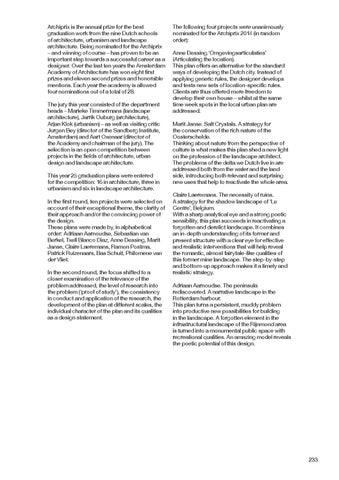Archiprix is the annual prize for the best graduation work from the nine Dutch schools of architecture, urbanism and landscape architecture. Being nominated for the Archiprix – and winning of course – has proven to be an important step towards a successful career as a designer. Over the last ten years the Amsterdam Academy of Architecture has won eight first prizes and eleven second prizes and honorable mentions. Each year the academy is allowed four nominations out of a total of 28. The jury this year consisted of the department heads – Marieke Timmermans (landscape architecture), Jarrik Ouburg (architecture), Arjan Klok (urbanism) – as well as visiting critic Jurgen Bey (director of the Sandberg Institute, Amsterdam) and Aart Oxenaar (director of the Academy and chairman of the jury). The selection is an open competition between projects in the fields of architecture, urban design and landscape architecture. This year 25 graduation plans were entered for the competition: 16 in architecture, three in urbanism and six in landscape architecture. In the first round, ten projects were selected on account of their exceptional theme, the clarity of their approach and/or the convincing power of the design. These plans were made by, in alphabetical order: Adriaan Aarnoudse, Sebastian van Berkel, Txell Blanco Diaz, Anne Dessing, Marit Janse, Claire Laeremans, Ramon Postma, Patrick Ruizenaars, Bas Schuit, Philomene van der Vliet. In the second round, the focus shifted to a closer examination of the relevance of the problem addressed, the level of research into the problem (‘proof of study’), the consistency in conduct and application of the research, the development of the plan at different scales, the individual character of the plan and its qualities as a design statement.
The following four projects were unanimously nominated for the Archiprix 2014 (in random order): Anne Dessing.‘Omgevingsarticulaties’ (Articulating the location). This plan offers an alternative for the standard ways of developing the Dutch city. Instead of applying generic rules, the designer develops and tests new sets of location-specific rules. Clients are thus offered more freedom to develop their own house – whilst at the same time week spots in the local urban plan are addressed. Marit Janse. Salt Crystals. A strategy for the conservation of the rich nature of the Oosterschelde. Thinking about nature from the perspective of culture is what makes this plan shed a new light on the profession of the landscape architect. The problems of the delta we Dutch live in are addressed both from the water and the land side, introducing both relevant and surprising new uses that help to reactivate the whole area. Claire Laeremans. The necessity of ruins. A strategy for the shadow landscape of ‘Le Centre’, Belgium. With a sharp analytical eye and a strong poetic sensibility, this plan succeeds in reactivating a forgotten and derelict landscape. It combines an in-depth understanding of its former and present structure with a clear eye for effective and realistic interventions that will help reveal the romantic, almost fairytale-like qualities of this former mine landscape. The step-by-step and bottom-up approach makes it a timely and realistic strategy. Adriaan Aarnoudse. The peninsula rediscovered. A narrative landscape in the Rotterdam harbour. This plan turns a persistent, muddy problem into productive new possibilities for building in the landscape. A forgotten element in the infrastructural landscape of the Rijnmond area is turned into a monumental public space with recreational qualities. An amazing model reveals the poetic potential of this design.
233
